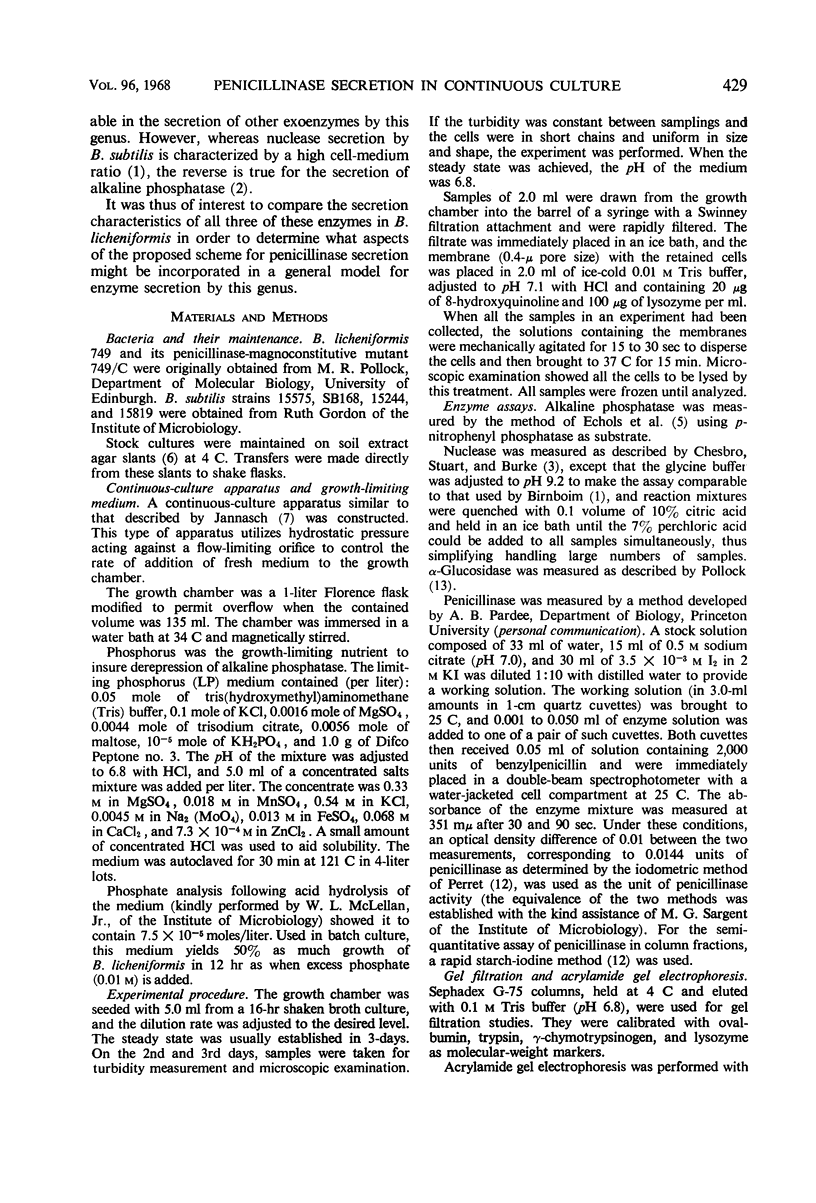Abstract
The distribution of alkaline phosphatase and nuclease activity between cells and medium was examined in one strain of Bacillus licheniformis and four strains of B. subtilis. Over 95% of both activities was found in the medium of the B. licheniformis culture, but in the B. subtilis cultures the amount of enzyme activity found in the medium varied with the strain and the enzyme considered. B. licheniformis 749 and its penicillinase magnoconstitutive mutant 749/C were grown in continuous culture with phosphorous as the growth-limiting factor, and the kinetics of penicillinase formation and secretion were examined. Nutrient arrest halted secretion (usually after a lag of about 30 min) in both the inducible and constitutive strains. Chloramphenicol did not eliminate secretion, but under certain circumstances reduced its rate. In the inducible strain treated with a low level of inducer, the rate of secretion was more affected by the rate of synthesis than by the level of cell-bound enzyme. During induction, the onset of accretion of cell-bound penicillinase and secretion of the exoenzyme were nearly simultaneous. It seems unlikely that a long-lived, membrane- or cell-bound intermediate is mandatory in the secretion of the three enzymes by Bacillus species. In the case of penicillinase secretion, there are at least two different phases. When penicillinase synthesis is proceeding rapidly, the rate of secretion is five to six times greater at equivalent concentrations of membrane-bound penicillinase than it is when penicillinase synthesis is reduced. The data require that any membrane-bound intermediate in the formation of exoenzyme be much shorter-lived in cells with a high rate of synthesis than in cells with a low rate. Either there are two separate routes for the secretion of penicillinase or the characteristics of the process vary substantially between the early stages and the declining phase of induction.
Full text
PDF









Selected References
These references are in PubMed. This may not be the complete list of references from this article.
- Birnboim H. C. Cellular site in Bacillus subtilis of a nuclease which preferentially degrades single-stranded nucleic acids. J Bacteriol. 1966 Mar;91(3):1004–1011. doi: 10.1128/jb.91.3.1004-1011.1966. [DOI] [PMC free article] [PubMed] [Google Scholar]
- COLLINS J. F. THE DISTRIBUTION AND FORMATION OF PENICILLINASE IN A BACTERIAL POPULATION OF BACILLUS LICHENIFORMIS. J Gen Microbiol. 1964 Mar;34:363–377. doi: 10.1099/00221287-34-3-363. [DOI] [PubMed] [Google Scholar]
- Cashel M., Freese E. Excretion of alkaline phosphatase of Bacillus subtilis. Biochem Biophys Res Commun. 1964 Aug 11;16(6):541–544. doi: 10.1016/0006-291x(64)90189-5. [DOI] [PubMed] [Google Scholar]
- Chesbro W. R., Stuart D., Burke J. J., 2nd Multiple molecular weight forms of staphylococcal nuclease. Biochem Biophys Res Commun. 1966 Jun 21;23(6):783–792. doi: 10.1016/0006-291x(66)90555-9. [DOI] [PubMed] [Google Scholar]
- ECHOLS H., GAREN A., GAREN S., TORRIANI A. Genetic control of repression of alkaline phosphatase in E. coli. J Mol Biol. 1961 Aug;3:425–438. doi: 10.1016/s0022-2836(61)80055-7. [DOI] [PubMed] [Google Scholar]
- JANNASCH H. W. [Bacterial growth at low substrate concentration]. Arch Mikrobiol. 1963;45:323–342. [PubMed] [Google Scholar]
- KUSHNER D. J., POLLOCK M. R. The location of cell-bound penicillinase in Bacillus subtilis. J Gen Microbiol. 1961 Oct;26:255–265. doi: 10.1099/00221287-26-2-255. [DOI] [PubMed] [Google Scholar]
- Lampen J. O. Cell-bound penicillinase of Bacillus licheniformis; properties and purification. J Gen Microbiol. 1967 Aug;48(2):249–259. doi: 10.1099/00221287-48-2-249. [DOI] [PubMed] [Google Scholar]
- Lampen J. O. Release of penicillinase by Bacillus licheniformis. J Gen Microbiol. 1967 Aug;48(2):261–268. doi: 10.1099/00221287-48-2-261. [DOI] [PubMed] [Google Scholar]
- PERRET C. J. Iodometric assay of penicillinase. Nature. 1954 Nov 27;174(4439):1012–1013. doi: 10.1038/1741012a0. [DOI] [PubMed] [Google Scholar]
- POLLOCK M. R. PURIFICATION AND PROPERTIES OF PENICILLINASES FROM TWO STRAINS OF BACILLUS LICHENIFORMIS: A CHEMICAL, PHYSICOCHEMICAL AND PHYSIOLOGICAL COMPARISON. Biochem J. 1965 Mar;94:666–675. doi: 10.1042/bj0940666. [DOI] [PMC free article] [PubMed] [Google Scholar]
- POLLOCK M. R. The measurement of the liberation of penicillinase from Bacillus subtilis. J Gen Microbiol. 1961 Oct;26:239–253. doi: 10.1099/00221287-26-2-239. [DOI] [PubMed] [Google Scholar]
- POLLOCK M. R. The mechanism of liberation of penicillinase from Bacillus subtilis. J Gen Microbiol. 1961 Oct;26:267–276. doi: 10.1099/00221287-26-2-267. [DOI] [PubMed] [Google Scholar]
- SMEATON J. R., ELLIOTT W. H., COLEMAN G. AN INHIBITOR IN BACILLUS SUBTILIS OF ITS EXTRACELLULAR RIBONUCLEASE. Biochem Biophys Res Commun. 1965 Jan 4;18:36–42. doi: 10.1016/0006-291x(65)90878-8. [DOI] [PubMed] [Google Scholar]
- Segal S. The formation of penicillinase by cysteine-starved auxotrophs of Bacillus licheniformis. Biochim Biophys Acta. 1965 Oct 11;108(2):297–305. doi: 10.1016/0005-2787(65)90014-6. [DOI] [PubMed] [Google Scholar]
- Yudkin M. D. Protein synthesis by long-lived messenger ribonucleic acid in bacteria. Biochem J. 1966 Aug;100(2):501–506. doi: 10.1042/bj1000501. [DOI] [PMC free article] [PubMed] [Google Scholar]


